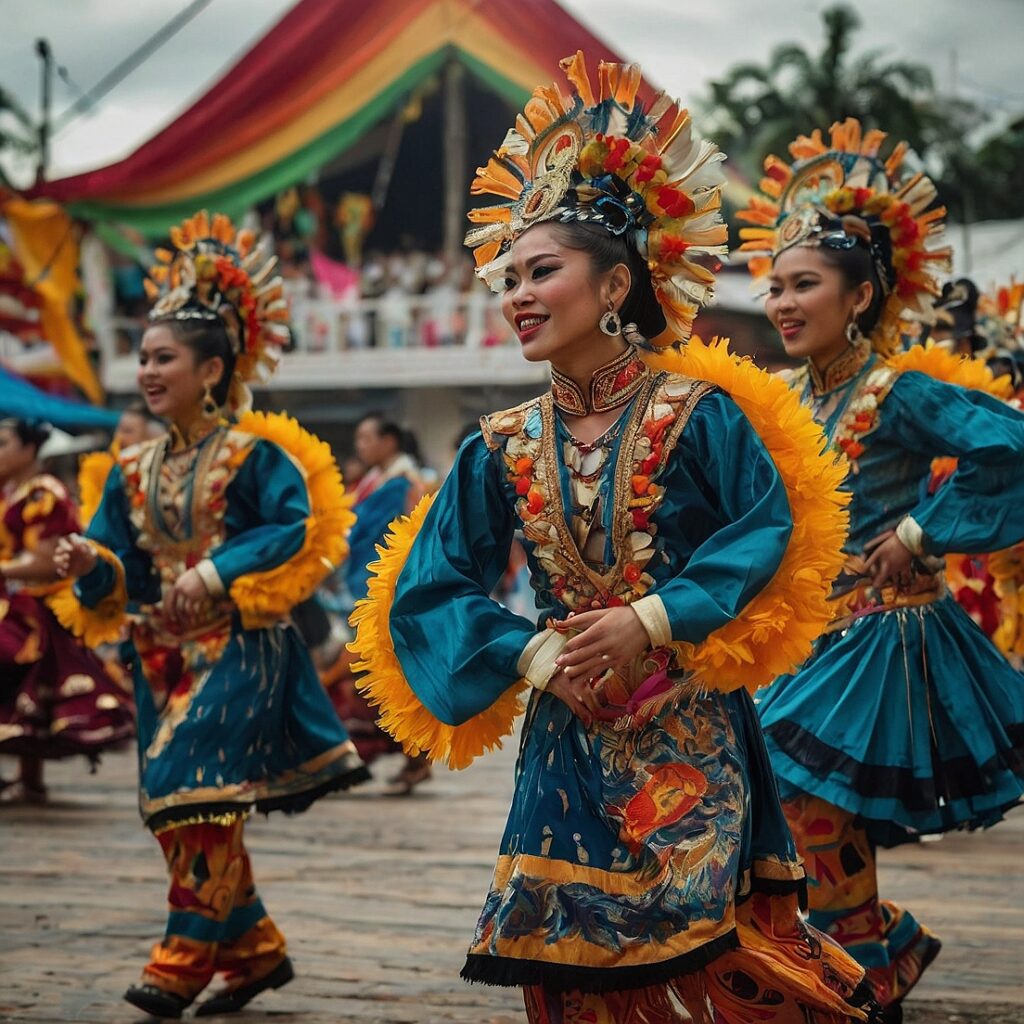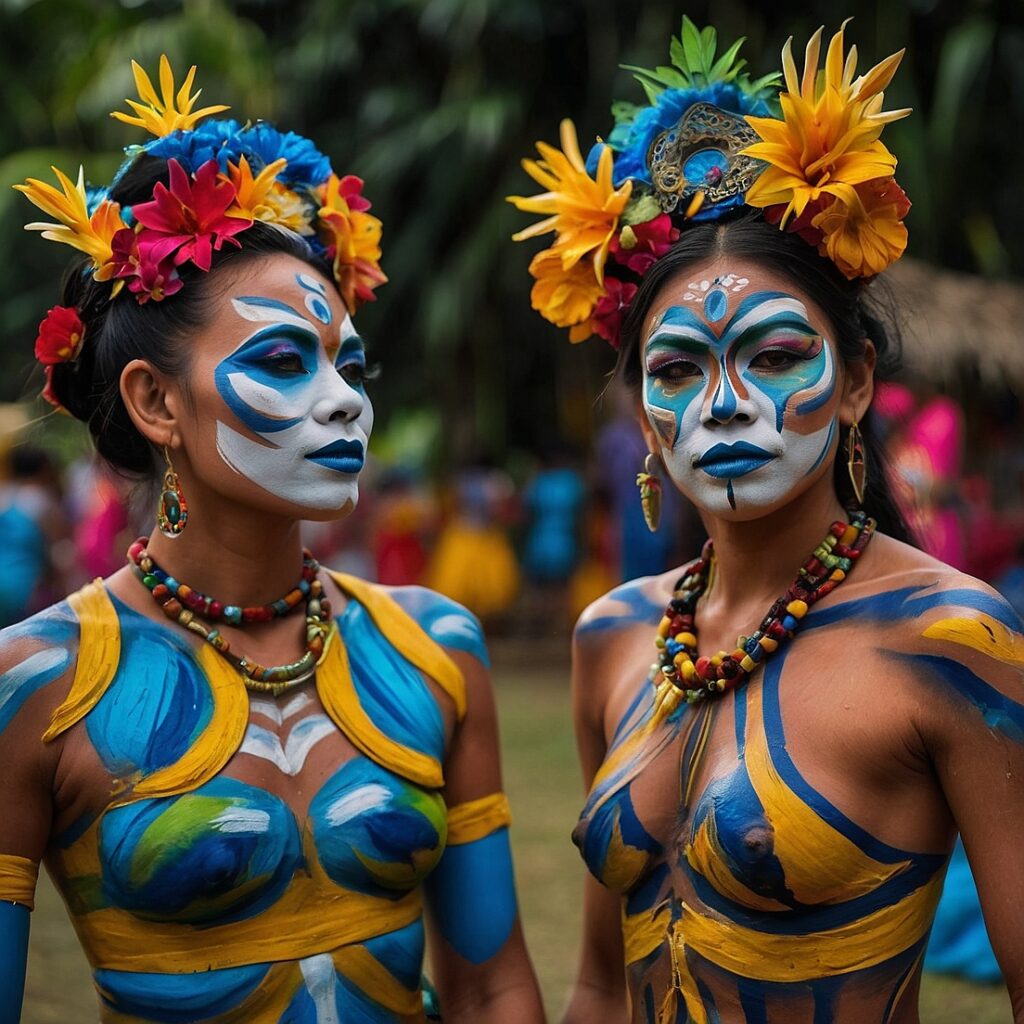Have you ever experienced a festival that makes your heart beat in sync with thousands of others? A celebration so vibrant and colorful that it feels like the entire city is pulsing with energy? If not, then let me introduce you to Sinulog – one of the Philippines’ most spectacular and meaningful festivals. Held annually in Cebu City, Sinulog is a feast for the senses, a cultural extravaganza that draws millions of visitors from across the globe. At the heart of this grand celebration are the mesmerizing music and dance performances that bring the streets to life. In this blog, we’ll dive deep into the rhythms of Sinulog, exploring the intricate choreography, the pulsating beats, and the rich cultural heritage that make this festival truly unforgettable.
The Origins and Evolution of Sinulog
A Dance with Ancient Roots
To truly appreciate the music and dance of Sinulog, we need to travel back in time. The origins of this festival can be traced back to the pre-colonial era of the Philippines. Long before the arrival of Spanish conquistadors, the natives of Cebu performed a ritual dance to honor their animist idols. This dance, characterized by a two-steps-forward, one-step-backward movement, mimicked the gentle back-and-forth flow of the river – “sulog” in the local dialect. Little did they know that this simple dance would evolve into one of the most spectacular cultural showcases in the country.
The Influence of Christianity
With the arrival of Christianity in the 16th century, the dance took on a new meaning. The story goes that Ferdinand Magellan, upon arriving in Cebu in 1521, presented an image of the Santo Niño (Holy Child Jesus) to Rajah Humabon and Queen Juana as a baptismal gift. The image was later found unscathed after a fire that razed the village, an event considered miraculous by the locals. From then on, the dance became a way to honor the Santo Niño, blending indigenous traditions with Christian devotion.
Modern-Day Celebrations
Fast forward to today, and Sinulog has transformed into a grand spectacle that draws millions of spectators each year. The festival, celebrated every third Sunday of January, has become a cornerstone of Cebuano culture and a major tourist attraction. While the core elements of the dance remain, the performances have evolved to include elaborate costumes, complex choreography, and a mix of traditional and modern music. It’s a testament to how cultural traditions can adapt and thrive in the modern world while still honoring their roots.
The Music of Sinulog: A Symphony of Cultures
Traditional Beats Meet Modern Rhythms
At the heart of every Sinulog performance is the music – a pulsating, energetic blend of traditional and contemporary sounds. The classic Sinulog beat, played on drums and gongs, forms the backbone of the festival’s soundscape. This hypnotic rhythm, with its distinctive “one-two-three, one-two-three” pattern, echoes the two-steps-forward, one-step-back movement of the dance. But don’t be surprised if you hear modern pop or electronic dance music mixed in with the traditional beats. Sinulog’s music has evolved to embrace a wide range of styles, creating a unique fusion that appeals to both older and younger generations.
The Role of Live Bands and DJs
While recorded music is common during street performances, the main Sinulog parade often features live bands and DJs. These musicians play a crucial role in maintaining the energy of the performers and the crowd throughout the long procession. The interplay between live performers and dancers adds an element of spontaneity and excitement to the festivities. You might hear anything from traditional Filipino folk songs to the latest chart-toppers, all infused with that infectious Sinulog rhythm.
The Sinulog Anthem: A Rallying Cry
No discussion of Sinulog music would be complete without mentioning the Sinulog Anthem. Composed in 1980 by Gregorio Abellana, this song has become synonymous with the festival. Its catchy melody and uplifting lyrics celebrate the Santo Niño and the spirit of Sinulog. During the festival, you’ll hear this anthem played countless times, with crowds enthusiastically singing along. It’s more than just a song – it’s a unifying force that brings together locals and visitors in a shared expression of faith and joy.
The Dance of Sinulog: A Visual Spectacle
The Basic Steps: Sinulog’s Signature Move
At its core, the Sinulog dance is deceptively simple. The basic step involves moving two steps forward and one step back, creating a flowing motion that resembles the movement of water in a river. This fundamental pattern is the foundation upon which all Sinulog performances are built. But don’t let its simplicity fool you – mastering the rhythm and grace of this movement takes practice and skill.
Elaborate Choreography: Taking it to the Next Level
While the basic step remains central, modern Sinulog performances have evolved to include complex choreography that can rival professional dance productions. Dance troupes spend months perfecting their routines, which often tell stories from Philippine history or depict scenes from daily life. These performances are a whirlwind of color and movement, with dancers seamlessly transitioning between traditional Sinulog steps and more contemporary dance moves.
Costumes and Props: A Feast for the Eyes
One of the most striking aspects of Sinulog dance performances is the elaborate costumes and props. Dancers are typically adorned in brightly colored outfits inspired by traditional Filipino dress, often embellished with intricate beadwork, sequins, and feathers. Many carry props such as candles, flowers, or images of the Santo Niño. The visual impact of hundreds of dancers moving in unison, their costumes shimmering in the sunlight, is truly breathtaking.
The Grand Sinulog Parade: The Ultimate Performance
A Day-Long Spectacle
The highlight of the Sinulog festival is undoubtedly the Grand Sinulog Parade, held on the final Sunday of the celebration. This massive event features dozens of dance contingents from various schools, communities, and even other provinces competing for top honors. The parade typically starts in the morning and can last well into the evening, with each group presenting a 5-10 minute performance along the route.
Judging Criteria: What Makes a Winning Performance?
The competition aspect of the Grand Parade adds an extra layer of excitement to the proceedings. Judges evaluate each contingent based on several criteria:
| Criteria | Description | Percentage |
|---|---|---|
| Choreography | Overall dance composition and execution | 30% |
| Performance | Energy, synchronization, and crowd impact | 25% |
| Costume and Props | Visual appeal and relevance to the theme | 20% |
| Music | Quality of musicality and adherence to Sinulog beat | 15% |
| Concept | Originality and relevance of the storyline | 10% |
These criteria ensure that winning performances are not just visually stunning but also meaningful and true to the spirit of Sinulog.
The Cultural Significance of Sinulog Music and Dance
Preserving Tradition in a Modern World
In an era of rapid globalization, festivals like Sinulog play a crucial role in preserving cultural heritage. The music and dance performances serve as a living link to the past, allowing younger generations to connect with their roots. At the same time, the evolution of these art forms demonstrates the dynamism of Filipino culture, capable of adapting to changing times while maintaining its core identity.
A Medium for Storytelling
Sinulog performances are more than just entertainment – they’re a form of storytelling. Through dance and music, performers narrate tales from Philippine history, folklore, and daily life. This visual and auditory storytelling helps keep cultural narratives alive and accessible to a wide audience, including those who might not engage with these stories in more traditional formats.
Building Community and Identity
The preparation for Sinulog performances fosters a strong sense of community. Dance troupes, musicians, costume designers, and countless volunteers work together for months leading up to the festival. This collaborative effort strengthens social bonds and reinforces a shared cultural identity. For many Cebuanos, participating in Sinulog is a source of immense pride and a way to express their cultural heritage.
The Economic Impact of Sinulog Performances
Boosting Tourism and Local Economy
The allure of Sinulog’s music and dance performances extends far beyond cultural significance – it’s also a major economic driver for Cebu. The festival attracts millions of visitors each year, providing a significant boost to the local tourism industry. Hotels, restaurants, transportation services, and local artisans all benefit from the influx of tourists eager to experience the spectacle of Sinulog.
Creating Opportunities for Artists
Sinulog creates numerous opportunities for local artists, musicians, and performers. From choreographers and dance instructors to costume designers and prop makers, the festival generates employment and helps sustain traditional crafts. Many performers who start in Sinulog go on to successful careers in the entertainment industry, using the festival as a launching pad for their talents.
Challenges and Controversies
Balancing Tradition and Commercialization
As Sinulog has grown in popularity, it has faced challenges in maintaining its cultural integrity. Some critics argue that the increasing commercialization of the festival risks overshadowing its religious and cultural significance. Finding a balance between preserving tradition and embracing the economic benefits of tourism remains an ongoing challenge for organizers.
Environmental Concerns
The massive scale of Sinulog celebrations has also raised environmental concerns. The sheer number of people gathered in one place can lead to issues with waste management and pollution. In recent years, there have been efforts to make the festival more environmentally friendly, including initiatives to reduce single-use plastics and improve waste disposal systems.
The Future of Sinulog Music and Dance
Embracing Technology
As we look to the future, technology is likely to play an increasingly significant role in Sinulog performances. We’re already seeing the integration of digital elements in some routines, such as LED costumes or projection mapping. These technological enhancements offer new ways to tell stories and create immersive experiences while still honoring traditional elements.
Global Recognition and Cultural Exchange
Sinulog’s reputation continues to grow on the global stage. As more international visitors experience the festival, there’s potential for greater cultural exchange. We might see Sinulog-inspired performances at international events or collaborations between Cebuano artists and performers from other cultures, further enriching the art form.
Adapting to Changing Times
The COVID-19 pandemic forced Sinulog organizers to reimagine the festival for a virtual audience in 2021. While challenging, this shift demonstrated the resilience and adaptability of the Sinulog tradition. As we move forward, it’s likely that digital platforms will continue to play a role in sharing Sinulog performances with a global audience, complementing the live experience.
The Enduring Rhythm of Sinulog
As we’ve explored in this journey through the rhythms of Sinulog, the music and dance performances are far more than mere entertainment. They are a vibrant expression of faith, culture, and community spirit. From its humble origins as a simple ritual dance to its current status as a world-renowned festival, Sinulog has continuously evolved while staying true to its core identity.
The pulsating beats, the graceful movements, the riot of colors – all these elements come together to create an experience that resonates deeply with both participants and spectators. Sinulog performances are a testament to the power of art to unite people, preserve traditions, and create joy.
Whether you’re a culture enthusiast, a music lover, or simply someone seeking a unique and unforgettable experience, the rhythms of Sinulog offer something truly special. So why not start planning your trip to Cebu for the next Sinulog festival? Come and immerse yourself in the music, the dance, and the incredible energy of this one-of-a-kind celebration. Who knows? You might just find yourself moving to the Sinulog beat long after the festival has ended.
Disclaimer: This blog post is based on information available up to 2021. While we strive for accuracy, some details may have changed since then. We encourage readers to verify current information about the Sinulog festival from official sources. If you notice any inaccuracies, please report them so we can correct them promptly.




